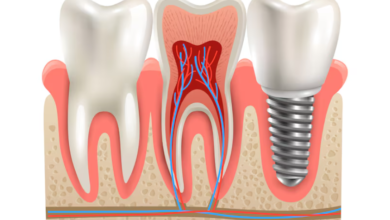how bad can a tooth be and still get a crown

Assessing Tooth Damage for Crown Suitability
Deciding if a tooth can be saved with a crown involves a close look at how much damage it has sustained. It’s not just about how it looks on the outside; a lot goes on beneath the surface. A good dentist in Midland will check several things to figure out if a crown is the right move.
Extent of Decay
When decay gets really bad, it can eat away a lot of the tooth structure. If the decay is so deep that it’s close to the nerve or has already reached it, a crown might be needed to protect what’s left. Sometimes, the decay is so widespread that a simple filling just won’t cut it anymore. The dentist needs to remove all the bad stuff, and if there’s not much tooth left after that, a crown provides the necessary strength.
Structural Integrity of the Tooth
Think of the tooth like a building. If the foundation is weak, the whole structure is at risk. A tooth might be weakened by cracks, chips, or just years of wear and tear. If a significant portion of the tooth’s natural structure is gone, or if there are deep fractures that go below the gum line, a crown can act like a sturdy cap, holding everything together and preventing further breakage. The goal is to restore the tooth’s strength and function.
Root Health Evaluation
Even if the part of the tooth you can see looks okay, the health of the root is super important. If the root is infected or damaged, a crown might not be enough. A dentist will check for signs of infection or bone loss around the root. Sometimes, a root canal treatment is needed before a crown can be placed. If the root itself is severely compromised, it might be too risky to put a crown on it, as it might not be stable enough.
When a Crown is the Best Solution
Sometimes, a tooth has been through a lot, and a simple filling just won’t cut it anymore. That’s where crowns come in. They’re like a sturdy helmet for your tooth, protecting what’s left and making it strong enough to chew with again. A crown is often the best solution when a tooth’s structure is significantly compromised.
Significant Tooth Fractures
If you’ve cracked or broken a tooth, especially if the fracture goes below the gum line or involves a large portion of the tooth, a crown is usually the way to go. It holds the pieces together and prevents further damage. Trying to fill a large fracture can be tricky and might not last.
Large Cavities Requiring Extensive Filling
When decay is really extensive, it can eat away so much of the tooth that a filling alone won’t be enough to rebuild it. Imagine trying to fill a big hole in a wall with just a little bit of plaster – it won’t hold. A crown covers the entire damaged part, giving you back a strong, functional tooth. This is common even with good oral hygiene, sometimes decay just gets in there.
Worn or Chipped Teeth
Teeth can wear down over time from grinding, or chip from accidents. If this wear or chipping is significant, affecting the tooth’s shape, function, or appearance, a crown can restore it. It’s not just about looks; worn teeth can lead to bite problems. For aesthetic concerns, especially in the front of the mouth, cosmetic dentistry in Midland, TX, can help, but for functional restoration, a crown is often needed. If you’re looking into teeth whitening Midland options, remember that crowns themselves don’t whiten, so it’s best to address structural issues first.
Understanding the Limits of Dental Restorations
Sometimes, even with the best intentions, a tooth might be too far gone for a crown to be the right fix. It’s not about judging the tooth, but about being realistic about what dental work can actually achieve.
Severely Compromised Tooth Roots
If the root of the tooth is in really bad shape, a crown might not have a solid foundation to hold onto. Think of it like trying to build a house on shaky ground; it’s just not going to last. The root needs to be healthy enough to support the crown and the forces it will face every day. If the root structure is compromised due to deep infection, extensive bone loss, or previous trauma, a crown might just be a temporary band-aid that won’t solve the underlying problem.
Advanced Gum Disease Affecting Support
Gum disease, especially when it’s advanced, can really weaken the support system for your teeth. When the gums and the bone that holds the teeth recede, there’s less tooth structure above the gum line to anchor a crown. This can make the tooth unstable, and putting a crown on it might not be effective. It’s like trying to put a hat on a pole that’s already leaning over.
Inability to Stabilize the Tooth
There are situations where, no matter what, the tooth just can’t be stabilized enough for a crown. This could be due to multiple cracks, significant loss of tooth structure, or if the remaining tooth is too short. A crown needs a certain amount of healthy tooth material to bond to and gain stability. If that material isn’t there, the crown won’t stay put or function properly. In these cases, a dentist in Midland might suggest other options, or even extraction, to address the issue properly. While we focus on restorative treatments, sometimes the best approach for your overall dental health, including options that might be considered part of cosmetic dentistry midland tx, involves acknowledging these limitations.
The Dentist’s Role in Crown Decisions
When you’re wondering if your tooth can be saved with a crown, your dentist is the key player. They’ve got the training to look at your tooth and figure out what’s really going on. It’s not just about how much decay you can see; there’s a lot more to it.
Expert Examination by Your Dentist in Midland
Your dentist in Midland will do a thorough check. They’ll poke around, look at the color of your tooth, and see how much of the natural tooth structure is left. They’re checking for cracks, how deep any cavities go, and if the tooth feels solid or a bit wobbly. It’s a hands-on assessment that gives them a lot of information.
Diagnostic Imaging for Clarity
Sometimes, you can’t see everything with just your eyes. That’s where X-rays come in. These images let your dentist see what’s happening below the gum line, checking the roots and the bone around them. They can spot decay that’s hidden or see if there’s any infection brewing. It’s like getting a secret peek inside your mouth to make sure everything is as it should be.
Personalized Treatment Planning
After the exam and any X-rays, your dentist will put all the pieces together. They’ll talk to you about what they found and what the best plan is. This might mean a crown, or maybe something else. They consider your overall dental health, not just the one tooth. If you’re interested in improving your smile’s appearance, they can also discuss options like cosmetic dentistry midland tx, or even teeth whitening midland if that’s something you’re looking into. The goal is to create a treatment that works specifically for you and your mouth.
Factors Influencing Crown Placement
When deciding if a crown is the right move for your tooth, a few things really come into play. It’s not just about how much decay there is, but also how the tooth handles pressure and how well you take care of your mouth.
Bite Force and Occlusal Stress
Think about how you chew. Some people grind their teeth (bruxism), which puts a lot of stress on dental work. If your bite is really strong or uneven, it can affect how long a crown lasts. A dentist in Midland will look at how your teeth meet to see if the forces are balanced. Too much pressure on one spot can chip or even break a crown, no matter how well it’s made. It’s like putting too much weight on a bridge; eventually, it might give way.
Patient’s Oral Hygiene Habits
This is a big one. Even the best crown won’t last if you’re not keeping up with brushing and flossing. Decay can still happen around the edges of the crown if plaque builds up. Good hygiene means the crown and the tooth underneath stay healthy. If you’re not great at cleaning your teeth, your dentist might suggest other options or really emphasize the importance of a good routine. It’s not just about the crown itself, but the health of the whole tooth and gum area.
Overall Dental Health Assessment
Your dentist will also look at your mouth as a whole. Do you have other dental problems? Is your gum health good? Are your other teeth strong? Sometimes, even if one tooth looks like it could take a crown, if the rest of your mouth isn’t in good shape, it might not be the best long-term solution. They might recommend treatments like teeth whitening midland or cosmetic dentistry midland tx to improve your overall smile before or alongside getting a crown. It’s about making sure the crown fits into a healthy, stable dental picture.
The success of a crown depends heavily on the health of the entire mouth, not just the single tooth being treated.
Alternatives to Crowns for Less Severe Issues
Sometimes, a tooth doesn’t need the full coverage a crown provides. If you’re dealing with minor issues, there are other ways to fix your teeth. For example, if you have a small cavity, a simple dental filling might be all that’s needed. These fillings are made from materials like composite resin, which can match your natural tooth color. They’re great for stopping decay in its tracks without needing to remove a lot of tooth structure.
Then there are veneers. These are thin shells, usually made of porcelain, that cover the front surface of your teeth. They’re mostly used for cosmetic reasons, like fixing chipped teeth, covering stains that even teeth whitening midland might not tackle, or closing small gaps. If you’re looking for a smile makeover, cosmetic dentistry midland tx has lots of options, and veneers are a popular one. They don’t require as much tooth preparation as a crown, making them a less invasive choice for certain aesthetic concerns.
Onlays and inlays are another option. Think of them as a middle ground between a filling and a crown. An inlay fits into a cavity within the tooth, while an onlay covers one or more cusps (the pointed parts) of the tooth. They’re custom-made by your dentist in Midland and bonded into place. These are good for cavities that are too large for a regular filling but don’t quite need a full crown. They help restore the tooth’s shape and function while preserving more of the natural tooth.
- Dental Fillings: Best for small to medium cavities.
- Veneers: Ideal for cosmetic improvements like chips, stains, or minor alignment issues.
- Onlays and Inlays: Suitable for larger cavities or teeth with damage to the cusps, offering more coverage than a filling but less than a crown.
These alternatives can often save more of your natural tooth structure compared to a full crown.
So, What’s the Verdict?
Ultimately, whether your tooth can get a crown really comes down to what your dentist sees. It’s not just about how much of the tooth is left, but also how healthy the root and the surrounding gum are. Sometimes a tooth looks pretty rough, but with a little work, it can be saved. Other times, even if it seems okay on the surface, there might be deeper issues that make a crown a no-go. The best thing you can do is just ask your dentist. They’ll give you the straight scoop on your tooth’s situation and what your options are. Don’t be shy about it!





